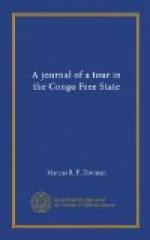We arrived at Stanleyville in the afternoon. The town is situated on the north bank of the river and consists of streets of large well built houses with much space in between which is laid out in gardens. On the opposite bank are the works of the railway to Ponthierville, a number of corrugated iron buildings and a large native village. In front, a hundred yards up the river, the lowest of the Stanley Falls can be seen, the white foam glistening in the sunlight as the water rushes over the rocks. The Commissaire of the District—the Province Orientale—Lieutenant De Neullemeister, kindly lends me a house and acts as my host. Fish is very plentiful here, but a sudden and terrible disease has suddenly carried off most of the goats and chickens and we are therefore, rather short of fresh meat for a few days.
Many of the natives have the Arab type of features and their village is quite Arabian in appearance. They are all very civilised and work well, so that much rubber is collected, although the population about Lake Tanganika is not very dense. The women here are clothed and do not work in the plantations at all.
Next day Lieutenant De Neullemeister and I, cross the river and are met by Mr. Adams, the Director of the Railway Company. We enter a truck and proceed along the new line which plunges into dense forest immediately, turning and twisting in many directions in order to avoid the numerous soft places and ravines and although there are a few steep gradients, most of the way the line runs on fairly level ground. The soil is a kind of ferruginous clay in some places and sandy in others and all the bridges are constructed of wood. Mr. Adams says the natives are good workers and that they have had no trouble with them and very little sickness. The gauge of the line is considerably wider than that of the Matadi-Leopoldville railway and at present about thirty kilometres have been finished the whole passing through thick forest with clearings here and there for the huts of the workmen. The difficulties of construction are very great, but these are being surmounted and the cost of transport of material is enormous, for every steel rail six of which weigh a ton has to be carried from Europe to Matadi by ship, then by the railway to Leopoldville, and then up the river for nearly a thousand miles. The Company has its own private steamer, the Kintamo, a stern wheeler of 500 tons which is the largest vessel on the Congo, but like the rest was carried out in sections and put together and launched at Leopoldville. The construction of this railway will thus be costly, and it is doubtful if the amount of produce carried will be sufficient for some years to pay a dividend. The advantages of it will however, be very great, for at present the falls render the river useless for navigation, and everything has to be carried round by hand. Everywhere indeed, there is evidence that the State not only spends enormous sums in opening up the country,




